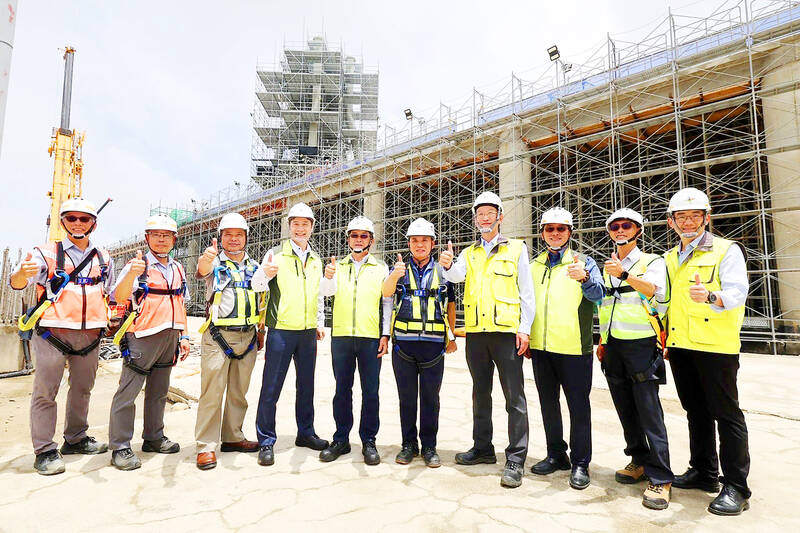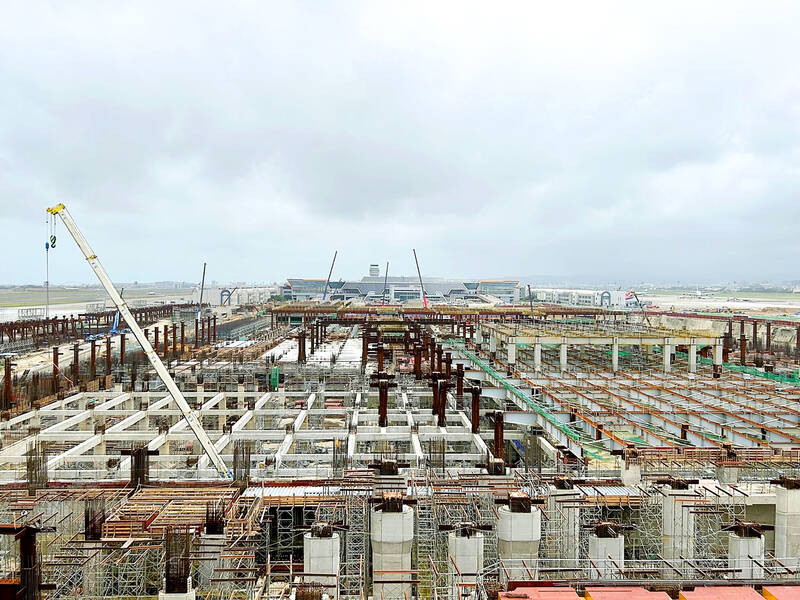Construction of Taiwan Taoyuan International Airport’s Terminal 3 continues, and yesterday, Taoyuan International Airport Corp (TIAC) chairman Yang Wei-fuu and chief executive officer Fan Hsiao-lun visited the main terminal construction site to inspect the assembly of the first giant roof structure column and to encourage the hardworking construction team.
This year, Taiwan Taoyuan International Airport’s travel recovery has been significant, with passenger volume in the first half of the year already surpassing 60 percent of pre-COVID-19 levels. The initiation of the giant column lifting project marks a new milestone in the construction of Terminal 3, moving toward its completion in 2026, which aims to provide service for 82 million passengers annually.
NEW PHASE BEGINS

Photo courtesy of TIAC
Yang said that the giant column lifting is an important milestone in the Terminal 3 project, signifying the entry into the next critical stage as the 210,000m2 terminal begins to take shape.
With the full efforts of TIAC and the construction team, as of Monday, the overall progress of the Terminal 3 civil engineering project, jointly undertaken by Samsung C & T and RSEA Engineering Corp, has reached 19.67 percent, slightly ahead by 0.32 percent.
The steel structure from the second basement to the third floor of the terminal has been fully completed. The construction of the north boarding concourse, the first phase target, is visible with its architectural outline.

Photo courtesy of TIAC
The steel structure and reinforced concrete works below the third floor are currently underway, and it is expected to be completed by the end of next year, providing passenger services connected to the operation of Terminal 2.
Simultaneously, the main terminal, office building, north airport road, and north boarding concourse are all under construction simultaneously and have now entered a peak construction period.
After completion, they are to accommodate more passengers and flights, improve travel service quality, consolidate the airport’s position as an important aviation hub in East Asia and enhance the nation’s competitiveness.
A MASSIVE PROJECT
TIAC said that Terminal 3 measures 414m in length from east to west and 242m in width from north to south, equivalent to three laid-flat Taipei 101 buildings. With three underground floors and four above ground, the total floor area is 580,000m2, making it the largest single-volume public project in the country after the Ten Major Construction Projects.
The most distinctive features of the building are the large-span wave-like roof along with indoor and outdoor cloud ceiling systems. To reduce structural physical volume and increase stability, it is supportan ) by 16 giant columns, each 19m high and weighing about 200 tonnes, along with their trusses. Therefore, the giant column lifting is the most challenging project in the overall plan.
In order to familiarize the staff with this high-difficulty construction work in advance, the construction team has specially created a simulation model site, producing models of the giant columns, ceilings, curtains and other objects.
Through careful calculations and testing before construction, they have confirmed the construction methods and planned standard operating procedures, reducing uncertainties on the construction site while ensuring safety and control of the construction schedule.
Taoyuan International Airport special report

Chinese Nationalist Party (KMT) Chairman Eric Chu (朱立倫), spokeswoman Yang Chih-yu (楊智伃) and Legislator Hsieh Lung-chieh (謝龍介) would be summoned by police for questioning for leading an illegal assembly on Thursday evening last week, Minister of the Interior Liu Shyh-fang (劉世芳) said today. The three KMT officials led an assembly outside the Taipei City Prosecutors’ Office, a restricted area where public assembly is not allowed, protesting the questioning of several KMT staff and searches of KMT headquarters and offices in a recall petition forgery case. Chu, Yang and Hsieh are all suspected of contravening the Assembly and Parade Act (集會遊行法) by holding

PRAISE: Japanese visitor Takashi Kubota said the Taiwanese temple architecture images showcased in the AI Art Gallery were the most impressive displays he saw Taiwan does not have an official pavilion at the World Expo in Osaka, Japan, because of its diplomatic predicament, but the government-backed Tech World pavilion is drawing interest with its unique recreations of works by Taiwanese artists. The pavilion features an artificial intelligence (AI)-based art gallery showcasing works of famous Taiwanese artists from the Japanese colonial period using innovative technologies. Among its main simulated displays are Eastern gouache paintings by Chen Chin (陳進), Lin Yu-shan (林玉山) and Kuo Hsueh-hu (郭雪湖), who were the three young Taiwanese painters selected for the East Asian Painting exhibition in 1927. Gouache is a water-based

Taiwan would welcome the return of Honduras as a diplomatic ally if its next president decides to make such a move, Minister of Foreign Affairs Lin Chia-lung (林佳龍) said yesterday. “Of course, we would welcome Honduras if they want to restore diplomatic ties with Taiwan after their elections,” Lin said at a meeting of the legislature’s Foreign Affairs and National Defense Committee, when asked to comment on statements made by two of the three Honduran presidential candidates during the presidential campaign in the Central American country. Taiwan is paying close attention to the region as a whole in the wake of a

OFF-TARGET: More than 30,000 participants were expected to take part in the Games next month, but only 6,550 foreign and 19,400 Taiwanese athletes have registered Taipei city councilors yesterday blasted the organizers of next month’s World Masters Games over sudden timetable and venue changes, which they said have caused thousands of participants to back out of the international sporting event, among other organizational issues. They also cited visa delays and political interference by China as reasons many foreign athletes are requesting refunds for the event, to be held from May 17 to 30. Jointly organized by the Taipei and New Taipei City governments, the games have been rocked by numerous controversies since preparations began in 2020. Taipei City Councilor Lin Yen-feng (林延鳳) said yesterday that new measures by